Bar terminology is a unique language essential for communication in the bartending world. It encompasses tools, techniques, and ingredients, forming the foundation of mixology and customer interaction.
1.1 Importance of Bar Terminology
Understanding bar terminology is crucial for efficiency and clear communication. It ensures consistency in drink preparation, enhances customer experience, and streamlines operations. Proper terminology helps bartenders work seamlessly, whether measuring ingredients, describing techniques, or serving cocktails, making it a cornerstone of professional mixology and effective customer interaction.
1.2 Brief History of Bar Terms
Bar terminology has evolved over centuries, reflecting the development of mixology. Terms originated from historical practices, cultural influences, and early mixologists like Jerry Thomas. These expressions have been refined and standardized, ensuring clarity and consistency in communication within the bartending industry worldwide.
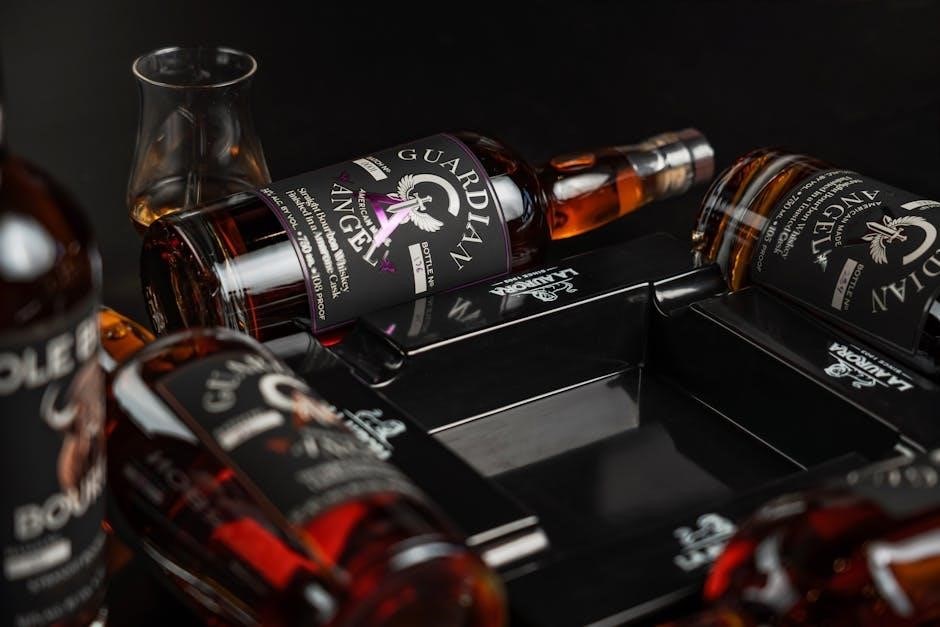
Common Bar Terms Starting with D
Discover essential bar terms starting with ‘D’: Daisy, a fruity sour; Dash, a few drops; Dirty, adding olive brine; Double, twice the alcohol; and Dry, minimal vermouth.
2.1 Daisy: A Large Sour Drink
A Daisy is a classic sour cocktail, typically made with gin or rum, mixed with citrus juice and sweetened with syrup. Served over crushed ice in a tall glass, it’s a refreshing, fruity drink perfect for warm occasions.
2.2 Dash: A Few Drops of an Ingredient
A dash refers to a small quantity of an ingredient, typically a few drops, used to enhance flavor in cocktails. Commonly employed for bitters, citrus zest, or syrups, it allows bartenders to subtly adjust a drink’s profile without overpowering it, ensuring a balanced taste and versatility in various mixes.
2.3 Dirty: A Twist in Color and Taste
A “dirty” drink involves adding an ingredient that alters its appearance and flavor. Most famously, a Dirty Martini includes olive brine, creating a cloudy effect and a savory twist. This technique allows bartenders to offer unique variations, enhancing both the visual appeal and taste profile of classic cocktails.
2.4 Double Drink: Twice the Usual Alcohol
A “double drink” refers to a cocktail made with twice the standard amount of alcohol. This term is often used when a customer requests a stronger version of their favorite drink, ensuring a more potent serving while maintaining the balance of other ingredients and flavors in the recipe.
2.5 Dry: Minimal Vermouth in Martini
A “dry” martini refers to a cocktail made with minimal vermouth, emphasizing the gin flavor. The term indicates a preference for a stronger, less diluted drink, with vermouth added sparingly, often just rinsed or sprayed, to enhance crispness without overpowering the spirit’s taste.
Bar Lingo and Industry Jargon
Bar lingo and industry jargon are essential for clear communication behind the counter. Terms like jigger, muddler, and layering describe tools and techniques, ensuring efficiency and precision in crafting drinks.
3.1 Bar Spoon: Long-Handled Mixing Spoon
A bar spoon is a long-handled tool used for mixing and layering drinks. Its extended design allows bartenders to reach deep into tall glasses or shakers, ensuring thorough blending. Often featuring a spiral handle, it’s perfect for crafting layered cocktails and floating ingredients for visual appeal.
3.2 Jigger: Measuring Device for Liquor
A jigger is an essential tool for accurate liquor measurement. Typically hourglass-shaped, it has two sides: one for 1 ounce (30ml) and the other for 2 ounces (60ml). This device ensures precise pours, maintaining consistency in cocktail recipes and reducing waste, making it a bartender’s go-to for efficient and accurate mixing.
3.3 Layering: Floating Liquids for Visual Effect
Layering involves carefully floating one liquid over another to create visually appealing drinks. Using tools like the back of a spoon, bartenders pour slowly to prevent mixing. This technique relies on density differences, with heavier liquids staying below lighter ones, enhancing the drink’s presentation and adding artistic flair to cocktails and shots.
Glossary of Essential Bar Terms
Float: Layering alcohol for visual effect. Flame: Setting a drink on fire. Free Pour: Measuring without tools. Twist: Citrus peel garnish. Muddle: Crushing ingredients. Garnish: Decorative drink addition.
4.1 Float: Alcohol Layering Technique
A float involves layering a denser alcohol over a lighter one for visual appeal. This technique uses gravity to separate liquids, creating distinct layers. Typically, a sweet or flavored liqueur is gently poured over a cocktail using a spoon to maintain separation. Common examples include layering grenadine in a Tequila Sunrise or Sambuca over coffee, enhancing both aesthetics and flavor profiles.
4.2 Flame: Setting a Drink on Fire
Flame refers to the technique of igniting a drink, creating a fiery presentation. Typically, high-proof alcohol like rum or absinthe is used due to its flammability. The flame enhances flavor and visual appeal, as seen in cocktails like the Flaming Lemon Drop or Sambuca. Safety precautions are essential to avoid accidents.
4.3 Free Pour: Measuring Without Tools
Free pour involves measuring liquor without tools, relying on skill and experience. Bartenders pour directly from the bottle, counting seconds to gauge the amount. This method requires practice for accuracy and is valued for its efficiency and creativity in crafting unique cocktails.
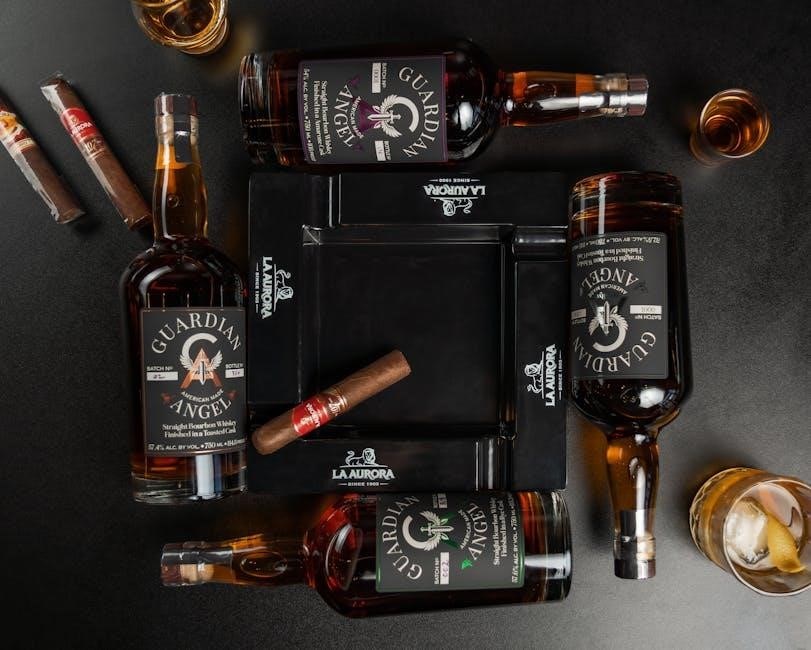
Glassware and Its Terminology
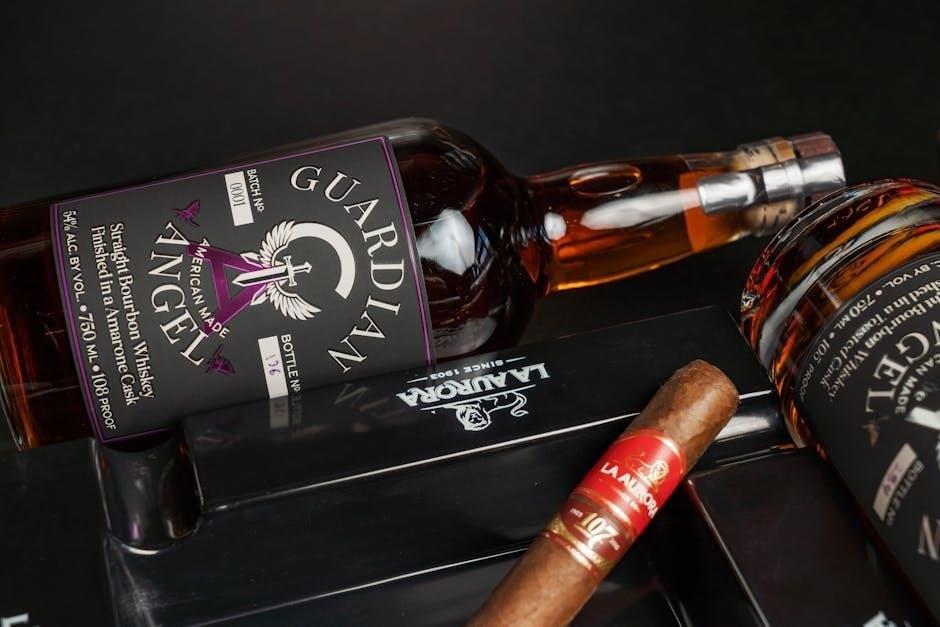
Glassware plays a vital role in enhancing the drinking experience. Common types include the highball, old fashioned, and martini glasses, each designed for specific drinks.
5.1 Highball Glass: Tall, Straight-Sided
The highball glass is a tall, straight-sided glass, typically 10–12 oz, used for serving drinks like Gin and Tonic. Its clear design and heavy base enhance both visual appeal and stability, making it a staple in bars for refreshing, mixed beverages;
5.2 Old Fashioned Glass: Short, Wide
The Old Fashioned glass is a short, wide glass, typically 6–8 oz, designed for serving whiskey, Old Fashioneds, and other spirits. Its wide mouth and heavy base enhance aroma and flavor, making it ideal for sipping and appreciating premium liquors.
5.3 Martini Glass: Conical Bowl
The Martini glass features a conical bowl, long stem, and narrow rim. Designed for cocktails like Martinis, it preserves aromas and maintains drink temperature. Its elegant shape enhances presentation, making it a symbol of sophistication in mixology and a favorite for serving classic and modern cocktails alike.
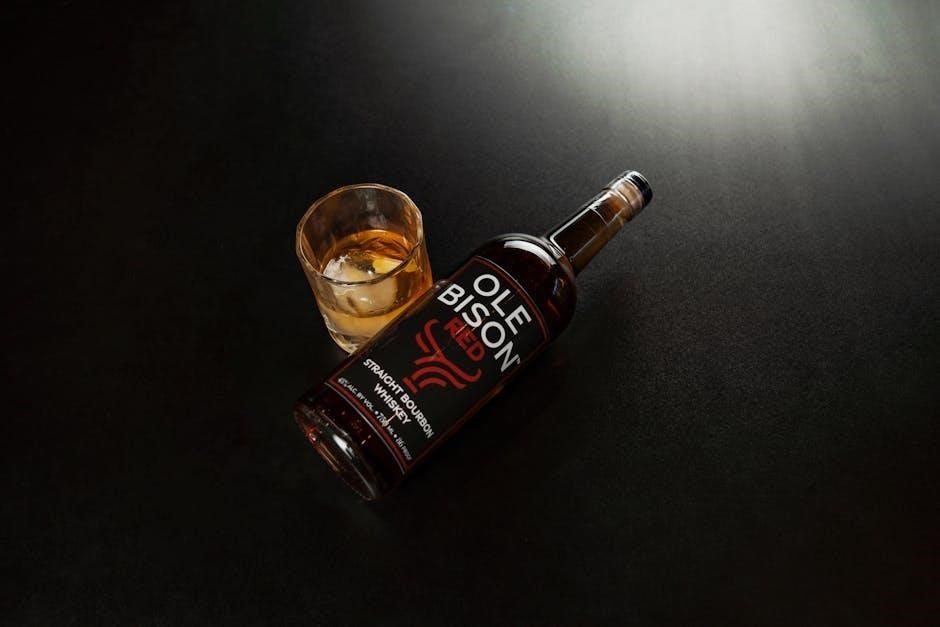
Classic Cocktails and Their Terminology
Classic cocktails like the Martini, Manhattan, and Old Fashioned are timeless staples. Each has distinct ingredients and preparations, embodying the essence of mixology and enduring popularity.
6.1 Martini: Gin, Vermouth, and Olive
The Martini, a classic cocktail, combines gin and vermouth, garnished with an olive or lemon twist. Variations include “Dry” (less vermouth) and “Extra Dry” (barely any). Served in a conical glass, it symbolizes sophistication and is a cornerstone of mixology, remaining a timeless favorite in bars worldwide.
6.2 Manhattan: Whiskey, Vermouth, Bitters
The Manhattan is a classic cocktail blending whiskey, vermouth, and bitters. Served straight up with a cherry garnish, it offers a robust mix of flavors. A timeless favorite, it’s a staple in mixology, symbolizing sophistication and craftsmanship behind the bar, perfect for those who enjoy strong, balanced drinks.
6.3 Old Fashioned: Whiskey, Sugar, Bitters
The Old Fashioned is a timeless cocktail blending whiskey, sugar, and bitters. A classic mix of smoky, sweet, and bitter flavors, it’s traditionally served over ice in a rocks glass with an orange peel garnish. Its simplicity and robust taste make it a favorite among whiskey enthusiasts and cocktail purists alike.
Techniques in Bartending
Techniques in bartending include shaking, stirring, and floating. Each method ensures proper mixing, chilling, and presentation of cocktails, enhancing both flavor and visual appeal.
7.1 Shaking: Mixing with Ice
Shaking is a fundamental bartending technique that involves mixing ingredients with ice in a shaker. It chills, dilutes, and emulsifies flavors, creating a smooth texture. Over-shaking can dilute the drink excessively, so timing is key to achieving the perfect balance of flavor and temperature in cocktails.
7.2 Stirring: Chilling Without Bruising
Stirring is a technique used to chill and dilute ingredients without introducing air or “bruising” the spirits. It’s typically used for clear cocktails like martinis or Manhattans. A bar spoon is gently stirred in a circular motion with ice to achieve the desired consistency and temperature without over-dilution or foam formation.
7.3 Floating: Layering Liquids
Floating involves layering liquids of different densities to create a visually appealing effect. This technique is often used in cocktails to separate flavors and colors. A spoon is typically used to slowly pour one liquid over another, ensuring the layers remain distinct and unmixed, enhancing both presentation and flavor balance.
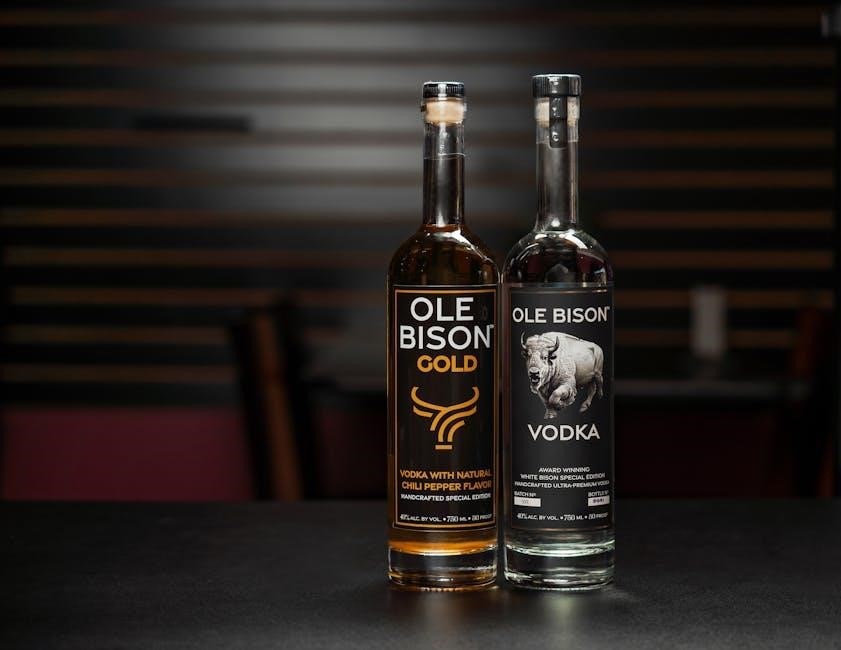
Essential Bar Tools
Essential bar tools include the muddler, Hawthorne strainer, and bitters bottle. These tools aid in preparing and presenting cocktails, ensuring precision and quality in every drink served.
8.1 Muddler: Crushing Ingredients
A muddler is a essential bar tool used to crush fruits, herbs, and spices in a shaker. It releases flavors and oils without tearing ingredients, enhancing the aroma and taste of cocktails, making it a must-have for bartenders to create delicious mixed drinks efficiently.
8.2 Hawthorne Strainer: Straining Cocktails
A Hawthorne strainer is a stainless steel tool with a spring-like design, used to strain cocktails into glasses. It fits securely on shaker tins, ensuring only liquid passes through while keeping ice and solids behind. Essential for professional bartending, it delivers a smooth, clean pour for a refined drinking experience.
8.3 Bitters Bottle: Adding Flavor Drops
A bitters bottle is a small, dasher-top container used to add precise amounts of bitters to cocktails. Its design allows controlled dispensing, enhancing flavor complexity without overpowering the drink. Essential in mixology, bitters add depth and balance to classic cocktails like the Old Fashioned and Manhattan.
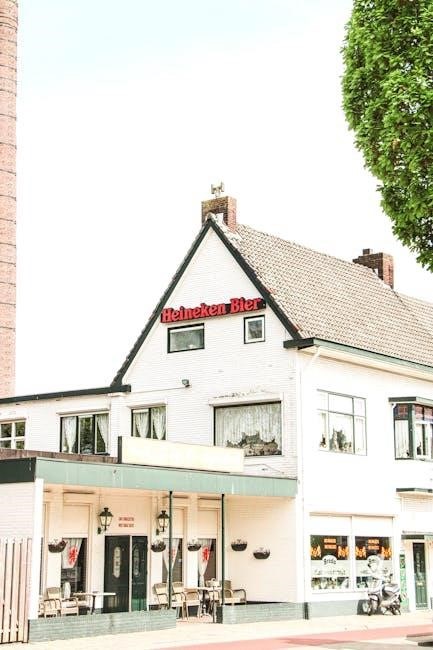
Advanced Bar Terminology
Advanced bar terminology includes specialized terms like “back,” “buy back,” and “call drink,” which enhance communication between bartenders and customers, streamlining service and elevating the drinking experience.
9.1 Back: Non-Alcoholic Mixer
A “back” is a non-alcoholic drink served alongside a cocktail, such as cola, water, or juice, intended to complement the main beverage. It enhances the drinking experience by providing a refreshing contrast, allowing customers to pace their alcohol consumption while enjoying their drink of choice.
9.2 Buy Back: Offering a Complimentary Drink
A “buy back” is when a bar offers a complimentary drink to a customer, often after purchasing a round or as a promotional gesture. It fosters goodwill, encourages loyalty, and enhances the overall customer experience, creating a positive impression and strengthening patron-bar relationships.
9.3 Call Drink: Specific Brand Request
A “call drink” occurs when a customer specifies a particular brand for their cocktail, such as “Gin and Tonic with Bombay Sapphire.” This indicates a preference for quality or taste, allowing bartenders to tailor the drink to the patron’s expectations, enhancing satisfaction and showcasing the brand’s prominence.
Profitability and Bar Terminology
Understanding bar terminology enhances sales, improves customer satisfaction, and streamlines operations, directly impacting profitability and efficiency in the bar industry.
10.1 Understanding Terminology for Better Sales
Mastering bar terminology allows bartenders to communicate effectively with customers, recommend drinks accurately, and upsell premium offerings. This enhances the customer experience, leading to increased sales and customer loyalty, which are crucial for a bar’s profitability and long-term success in the competitive hospitality industry.
10.2 Enhancing Customer Experience
Understanding bar terminology enables staff to clearly explain drink options, building trust and satisfaction. It fosters a welcoming environment, allowing bartenders to offer personalized recommendations. This expertise enhances the overall experience, making customers feel valued and ensuring a memorable visit to the bar.
10.3 Efficient Inventory Management
Understanding bar terminology aids in tracking stock levels, ordering, and usage patterns. Accurate terms help identify low-stock items and reduce waste, ensuring supplies meet demand. This clarity enhances profitability by preventing overstocking and shortages, optimizing inventory turnover, and maintaining a well-stocked bar.
Bar terminology continues to evolve, reflecting new techniques and ingredients. Staying informed ensures bartenders remain innovative, adapting to industry trends and enhancing the craft of mixology.
11.1 The Evolving Nature of Bar Terms
Bar terms evolve with industry advancements, influenced by new techniques, ingredients, and cultural trends. As mixology grows, terminology adapts, ensuring clear communication among professionals and enhancing the art of bartending for future generations.
11.2 Staying Updated with Industry Trends
Staying informed about industry trends is crucial for bartenders to remain relevant. Continuous learning through workshops, blogs, and social media helps adapt to new techniques, ingredients, and consumer preferences, ensuring expertise stays current and enhances the overall bartending experience.
